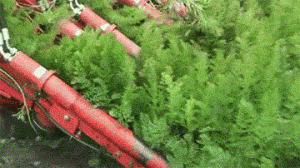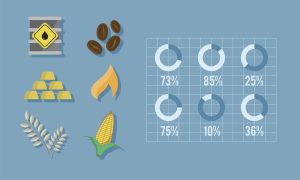The digital era has revolutionized many industries with the huge impact of big data. The overwhelming amount of information available on the web is estimated to reach 44 zettabytes by 2020 and it has proven to be of immense value to many industries, as well as large enterprise companies. Some industries that benefit from big data are the financial, airline, travel, restaurants, automobile, sports, and hospitality industries. The list may go on and on because big data can be a powerful tool in the hands of an industry expert. By the end of 2017, the adoption of big data by companies has reached 53%.
One industry that can greatly benefit from big data but may not instantly come to your mind is the agricultural sector. Yes, the agricultural industry also can make use of data in many practical ways and benefit from it greatly. Big data brings an innovative approach in almost every sector of the world, so why would agriculture be left behind. Although not many technologies can have an impact on the agricultural sector, big data is such a powerful force that it definitely has the potential to transform the agricultural domain. It’s extremely important that today farmers understand and value technology, in order to make decisions more quickly and methodically and not lag behind the innovative approaches.
The agricultural sector together with big data integrates into the concept known as Smart Farming. Keep reading to find out what smart farming is all about and the role of big data in it. Also, keep reading to learn many practical ways of how big data is leveraged in agriculture.
Smart Farming and the Role of Big Data
Today, the ultimate goal of agriculture is to achieve smart farming. The concept of smart farming refers to farm managing using modern Information and Communication Technologies, in order to increase the quality and quantity of products, while optimizing the required labor. The agricultural sector strives for smart farming and big data composes a huge part of this. Currently, the following technologies make smart farming possible:
- Software applications – specialized software solutions that target specific farm types.
- Sensors – sensing technologies that include soil, water, light, temperature management, and humidity.
- Positioning and location – GPS, Satellite, etc.
- Robotics and automation – autonomous tractors, processing facilities, systems that enable IoT-based solutions, etc.
- Data analytics – analytics solutions and data pipelines that help with decision making and prediction process.
- Communications systems – connectivity via cellular.
In smart farming, the driving force is the IoT, which connects smart machines and sensors integrated on farms and makes the farming processes data-driven and data-enabled. With all of the technology, farmers can collect data, monitor the field conditions without physically going to the field, and make strategic decisions. The main driving force behind the IoT is data and only data. The IoT devices installed on a farm collect and process data in specific repeated cycles to help farmers react to any emerging issues quickly. This is how IoT optimizes the farming process.
Here’s how the process looks like:
- Observation – firstly, sensors record observational data from the crops, soil, livestock, or atmosphere.
- Diagnostics – the data is then fed to a specific software platform with predefined decision rules and models that ascertain the conditions of the examined object to identify deficiencies or needs if any.
- Decisions – when specific issues are revealed, the software determines if any location-specific treatment is needed. If yes, then which exactly.
- Implementation – lastly, after the treatment is performed by the correct operation of machinery, the cycle repeats from the beginning.
The IoT is indeed a powerful tool that adds value to every aspect of farming, from growing crops to forestry. But IoT is only powerful due to the availability of Big Data.
How Data Technology Revolutionizes Agriculture
Technology and big data in agriculture have led to a better understanding of crops and the procedures to grow these crops better. There are 3 major ways how big data technology transforms agriculture and we’ll consider each.
Precision Farming
Precision farming, as the name implies, makes a precise plant and cattle treatment possible. The concept of precision farming stands for IoT-based approaches that enable more controlled and accurate farming. So the main difference from the classical approach is that with precision farming allows to make decisions per square meter or per plant rather than for a field. The level of accuracy is increased by precisely measuring variations within a field so that farmers can boost the effectiveness of pesticides and fertilizers and use them selectively.
Apt Crop Forecasts
For farmers, it’s always been a challenge to understand how exactly the crops will turn out. Until now, crop predictions had been quite inaccurate throughout many years. However, with the help of IoT, big data, and algorithms, crop predictions are now correct and accurate. Today, farmers can foresee the yields with absolute accuracy even before planting the seen in the soil. The available data of spans of weather and crop information from decades along with smart technological algorithms help to create precise analytics based on real data. Farmers get insights to initiate and harvest during the best time, and thus, maximize the harvests.

High-Quality Seeds and Philanthropy
The rapidly growing population in the world puts under the risk the resources. The threat of starvation has never been so real. That’s why there are currently numerous philanthropic programs that try to create impact worldwide. Big data may also help to resolve such serious issues as well. For many years, big data in agricultural research programs have been collected by scientists and researchers. The main idea behind such programs is to discover an ideal type of crops that can be cultivated in any environment. Due to many such programs, today farmers can already grow crops bigger, faster and healthier. Chemically engineered seeds that rely on big data analytics may sound weird now but the immense progress and potential of the industry have the power to put an end to global hunger.
Practical Ways to Use Big Data in Agriculture
1.Trends Monitoring
Farming always involved big risk factors, such as unexpected crop disease or natural disasters, that are out of the control of farmers. Extreme weather conditions have destroyed entire harvests and caused irreversible damage to farmers. However, such events are no longer unpredictable. Big data and technology can now entirely predict weather events and even pest problems, due to years of event tracking. By using past and present data in specific systems, farmers can now get insights through valid algorithms. Data science not only can save the harvest but also a lot of money to the stakeholders within the overall supply chain.
2.Supply Tracking
Usually, farmers that grow crops are a part of a specific supply chain. This means that farmers are liable to a particular supplier or partner. It’s hard for a farmer to know how much and when exactly a particular crop is going to be ready. So a problem may arise between the farmer and the partner because of the changing demand on the consumer side. That’s why supply issues often arise. Big data can solve problems that arise within the supply chain processes because it has more oversight regarding the crops and harvests each season. So not only the farmers but everyone in the supply chain (retailers, distributors, etc.) can benefit from this data and prepare for the current progress.
3.Yield Prediction
A special mathematical model combined with machine learning, on which yield prediction analysis is based upon, analyses data around yields, weather, leaf, chemicals, and biomass index. The data is used to crunch the stats and power up the decision-making process.
 PC: Rawpixel
PC: Rawpixel
Yield prediction allows the farmers to get insights on what to plant, where to plant, and when to plant. By using sensors to collect data, only a tiny amount of manual work is left to be done. The success would be guaranteed.
4. Crop Prediction and Consumer Demand Analysis
Many crops are seasonal and have a higher or lower demand based on the current season. For example, during the summer, the demand for strawberries is much higher than during wintertime. However, this doesn’t mean that during each strawberry season, strawberries have the same demand level. So it’s always hard to predict what the demand would be even during the peak season of a specific crop. Big data enables to make precise predictions and demand analysis at a more advanced level. Farmers are able to see how much crop they produced, how that impacted the customers, the effects on the supply and demand, and get tips on how to improve their operations. Big data helps to cut excess waste by giving insights to grow fewer crops due to lower demand while saving money and using the space to grow crops that are in higher demand.
- Risk Management
An accurate and reliable risk assessment report is critical for almost every industry out there. As important as it’s for the agricultural sector, the risk management area wasn’t available to farmers until recently. Back in 2014, the area of risk management created headlines as advice from data scientists to Colombian rice farmers, having saved millions in damages caused by shifting weather patterns. Farmers can now leverage big data and use data-driven risk assessments to evaluate the chances of disruptive events. Every potential mistake or obstacle can now be foreseen, along with appropriate solutions and expected results as well. Farmers can even use real-time data to make sure that the possible damage to crops is diminished to a minimum.
- Food Safety and Spoilage Prevention
Smart farming and big data are not only about ensuring minimal crop damage but also about improving food safety, the health of the crops and prevent spoilage. Due to the data collection of factors like temperature, humidity, and chemicals, modern farming can get a full picture of health around small agricultural businesses. This is a critical area of smart farming, which allows spotting any microbes and incidents of contamination instantly. The GMO contamination has caused costly damage to businesses before, so organic farmers are now more cautious. Early detection can not only lower the cost of contamination but also reduce a lot of wastage.
- Operation and Equipment Management
Agriculture and crop growing requires a lot of hard work on a daily basis. So we cannot underestimate the power of big data and technology in their ability to ease the daily work of running an agricultural business.
![]() PC: Rawixel
PC: Rawixel
The sensors help with providing data. Then, farmers long into special portals where they can manage all that data, and thereby their fleet, and maintenance of equipment to reduce downtime and keep everything productive and efficient. More companies, like John Deere, create technological solutions based on big data to improve areas of equipment management and supply chain optimization. They aim to help farmers plan, run and analyze their entire farming operation through the entire farming cycle as efficiently and productively as possible.
Technology and big data in agricultural research are very powerful means. Farmers are now even using drones with sensors to survey the crops, update data, and always be informed on all of the areas that require improvement. The power of big data in agriculture is immense and it strives to eliminate even the tiniest of errors in a system and create the best quality of crops.
Conclusion
Every farmer has the goal to reduce operational cost, increase product value, and improve efficiency. These goals are now completely achievable and realistic with the help of big data and smart farming techniques. Farmers can make more accurate and knowledgeable decisions, use reliable forecasts, and make use of the Big Data. So big data revolutionizes the agricultural industry and makes it a data-driven industry, while helping farmers in all of their operations.
Other images: Freepik


